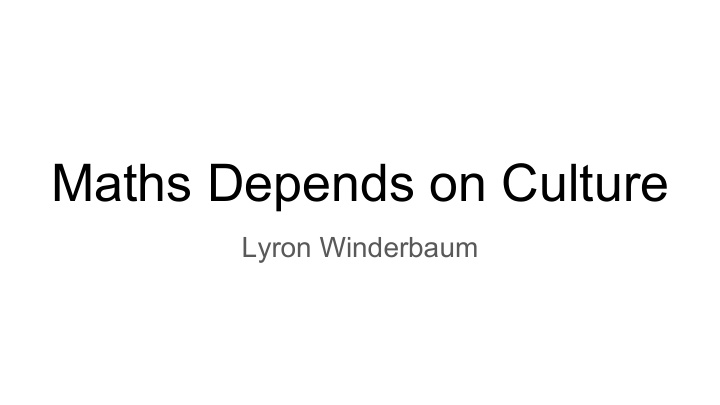



Maths Depends on Culture Lyron Winderbaum
The Process of Learning/Developing Maths
So Where Does Culture Fit? Our perception of reality is biased by our values. Our values are largely a product of our culture. So, Culture → Values → Perceptions → Maths. This effect can often be masked if teacher and Jordan Peterson student share a cultural background. But if they differ in cultural background, students may struggle to find any relevance in the maths as it won’t connect to their values.
Indigenous Students ``Indigenous students continue to be the most mathematically disadvantaged group in Australia’’ --- Matthews (2007) These poor educational outcomes cause decreased employment opportunities, and are correlated with poor health outcomes and risky behaviours.
Attendance - Symptom, not Cause. The fundamental problems in maths education for indigenous students are: ● Expectations, and ● Relevance To improve attendance a``build it and they will come’’ approach is needed.
Expectations Chris Sara has done fantastic work in this area, check out ● The Stronger Smarter Institute, and their ● High Expectations Relationships Framework
Relevance How can we make learning maths relevant? ● Placing in in contexts that have cultural importance to the students. ● Using culturally accepted practices to inform pedagogy. Easier said than done. Some examples: ● The Garma Maths program, ● Christopher Matthews work.
Garma Maths Is a program in the Yirrkala Community School in Arnhem Land, Northern Territory. --- Excerpt from Robinson et. al. (1998)
Christopher Matthews Is a Noonuccal (or Nunukal) man from the Moreton Bay area near Brisbane. He has a PhD in applied mathematics. Recently he has been developing strategies for engaging indigenous students in maths through culturally relevant pedagogies.
Mathematics through Storytelling and Dance --- Matthews (2007)
The Role of Language Maths is often described as a language. I would say maths has its own language used to describe it, and a large component of learning maths is learning the meaning of words used to describe it. If English is not a students first language, it is key to discuss terms and concepts across multiple languages in order to compare and contrast their meaning. Such discussions also offer a critical opportunity to uncover cultural differences. Even if teacher and student share linguistic backgrounds, if they differ in cultural backgrounds the meaning of words can differ.
Culture Differences Reflected in Language --- Excerpt from Graham (1982)
History… and Change? Indigenous disadvantage in maths education has been discussed in the literature since the 1980’s. The principles to be followed in terms of addressing this issue have been clearly and consistently laid out as far back as Wilson (1979). Examples of these principles being put into practice are given since the 90s (see the work of Robinson (1998) and Bucknell (1995) for example, or Matthews (2012) more recently). Yet, it is still not common practice. Why?
Conclusions Ultimately I think that taking into account a culture that is not your owns perspective is a very challenging thing to do, and the most important thing is to encourage greater diversity amongst maths teachers. Failing that however, I think the key things we can do is: ● Relationship building supported by cultural competency, ● Set high expectations, of both students and teachers. ● Engage in collaborative discourse to negotiate terms and meaning. ● Set the learning in a culturally relevant context.
References AIATSIS (https://aiatsis.gov.au/collections/collections-online/digitised-collections/ethnomathematics-australia/contents) Bishop, A. J. (1988). Mathematics education in its cultural context. Educational studies in mathematics , 19 (2), 179-191. Bucknall, G. (1995). Building bridges between Aboriginal and Western mathematics. The Australian Journal of Indigenous Education , 23 (1), 22-31. Closing the Gap (https://closingthegap.pmc.gov.au/education) Graham, B. (1982). Can we count on maths?. The Australian Journal of Indigenous Education , 10 (2), 4-10. Howard, P. (1995). Listening to what people have to say about mathematics: Primary mathematics and the thoughts of one Murri student. The Australian Journal of Indigenous Education , 23 (2), 1-8. Matthews, C., Watego, L. A., Cooper, T. J., & Baturo, A. R. (2005). Does mathematics education in Australia devalue Indigenous culture? Indigenous perspectives and non-Indigenous reflections. MERGA. Matthews, C., Cooper, T. J., & Baturo, A. R. (2007). Creating your own symbols: Beginning algebraic thinking with Indigenous students.
References Matthews, C. (2012). Maths as storytelling: Maths is beautiful. Aboriginal and Torres Strait Islander education: An introduction for the teaching profession , 94-112. Morris, C., & Matthews, C. (2011). Numeracy, mathematics and Indigenous learners: Not the same old thing. Indigenous Education: Pathways to Success , 29-33. Patrick-Rolf, M. (1990). Creating a Good Maths Learning Environment. Aboriginal Child at School , 18 (5), 15. Robinson, J. A., & Nichol, R. M. (1998). Building Bridges between Aboriginal and Western Mathematics: Creating an Effective Mathematics Learning Environment. Education in Rural Australia , 8 (2), 9-17. Rowlands, S., & Carson, R. (2002). Where would formal, academic mathematics stand in a curriculum informed by ethnomathematics? A critical review of ethnomathematics. Educational Studies in Mathematics , 50 (1), 79-102. Stronger Smarter Institute (https://strongersmarter.com.au/) Wilson, R. (1979). Mathematics Programs for Indigenous Students: Some Guidelines. The Australian Journal of Indigenous Education , 7 (5), 33-47.
Zeno’s Paradoxes (~450 BC) Reasoning is not fixed or absolute. We modify our reasoning to match our reality. We make observations of the world around us and let those observations guide our reasoning.
Different Perspectives Can be incredibly powerful mathematical tools. https://youtu.be/pQa_tWZmlGs
Recommend
More recommend